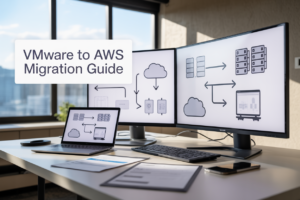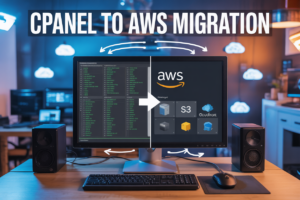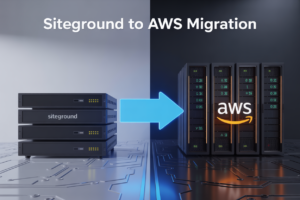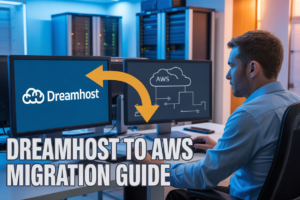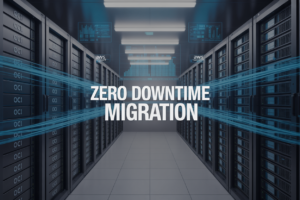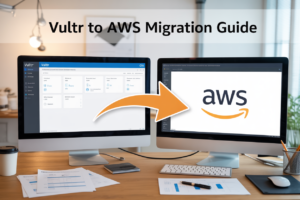Managing AWS load balancing can feel overwhelming when you’re trying to connect Auto Scaling Groups with Target Groups for smooth traffic distribution. This guide is designed for AWS engineers, DevOps professionals, and system administrators who want to master EC2 instance attachment and create reliable, self-healing infrastructure.
Auto Scaling Groups EC2 instances need to work seamlessly with your Application Load Balancer configuration to handle traffic spikes and failures automatically. When done right, your AWS auto scaling setup creates a robust system where new instances join your load balancer target group integration without manual intervention.
We’ll walk through the automatic attachment process that connects your scaling instances to Target Groups AWS, covering the essential configuration steps that make everything work together. You’ll also learn advanced monitoring techniques and troubleshooting strategies to keep your AWS infrastructure automation running smoothly, plus elastic load balancing best practices that prevent common pitfalls before they impact your applications.
Understanding AWS Load Balancing Fundamentals
Core Components of AWS Load Balancing Architecture
AWS load balancing architecture revolves around three essential components that work together to distribute incoming traffic efficiently. Load balancers act as the entry point, receiving client requests and routing them to healthy backend instances. Target groups serve as logical collections of resources, defining which EC2 instances should receive traffic and establishing health check parameters. Auto Scaling Groups EC2 instances provide the compute capacity that scales automatically based on demand, ensuring your application maintains optimal performance even during traffic spikes. These components integrate seamlessly through listeners that define ports and protocols, health checks that monitor instance availability, and routing rules that determine traffic distribution patterns across your infrastructure.
Benefits of Distributing Traffic Across Multiple Instances
Distributing traffic across multiple EC2 instances delivers significant advantages for application reliability and performance. High availability becomes achievable when load balancers automatically route requests away from failed instances to healthy ones, eliminating single points of failure. Performance improves dramatically as workloads spread across multiple servers, reducing response times and preventing individual instances from becoming bottlenecks. Cost optimization occurs through efficient resource utilization, allowing you to handle varying traffic patterns without over-provisioning infrastructure. Elastic load balancing best practices also enable fault tolerance, where your application continues operating even when individual components fail, while automatic scaling adjusts capacity based on real-time demand patterns.
Types of Load Balancers and Their Use Cases
Application Load Balancers excel at HTTP and HTTPS traffic management, offering advanced routing capabilities based on request content, headers, and URL paths. They support modern application architectures including microservices and containers, making them perfect for web applications requiring sophisticated traffic distribution. Network Load Balancers handle TCP, UDP, and TLS traffic with ultra-low latency, ideal for gaming applications, IoT devices, and any scenario requiring extreme performance at the transport layer. Classic Load Balancers provide basic load balancing across multiple EC2 instances for applications built within the EC2-Classic network, though they’re considered legacy for new deployments. Gateway Load Balancers integrate third-party virtual appliances like firewalls and intrusion detection systems directly into your traffic flow, enabling security and networking functions at scale.
Auto Scaling Groups: The Foundation of Dynamic Infrastructure
How Auto Scaling Groups Monitor and Respond to Demand
Auto Scaling Groups continuously watch your application’s performance through CloudWatch metrics like CPU usage, network traffic, and custom application metrics. When demand spikes, they automatically launch new EC2 instances within minutes, distributing them across multiple availability zones for reliability. During quiet periods, they scale down by terminating excess instances, keeping costs under control while maintaining your desired capacity levels.
Scaling Policies That Optimize Performance and Cost
Dynamic scaling policies adjust your infrastructure based on real-time conditions using target tracking, step scaling, or simple scaling methods. Target tracking maintains specific metrics like 70% CPU utilization, while step scaling adds or removes instances in increments based on alarm thresholds. Predictive scaling uses machine learning to forecast demand patterns, pre-scaling resources before traffic surges hit your application.
Instance Health Checks and Automatic Replacement
AWS auto scaling setup includes comprehensive health monitoring that checks both EC2 system status and application-level health through load balancer target group integration. When an instance fails health checks, the Auto Scaling Group immediately terminates the unhealthy instance and launches a replacement in the same availability zone. This process typically completes within 5-10 minutes, ensuring your application maintains consistent performance without manual intervention.
Integration with CloudWatch Metrics for Intelligent Scaling
CloudWatch provides the intelligence behind AWS infrastructure automation by collecting detailed metrics from your EC2 instances and load balancers. Custom metrics from your applications can trigger scaling events, while built-in alarms monitor everything from memory usage to request latency. This deep integration enables sophisticated scaling decisions that balance performance requirements with cost optimization, creating truly responsive infrastructure that adapts to your business needs.
Target Groups: The Bridge Between Load Balancers and Instances
Defining Target Group Configuration for Optimal Routing
Target Groups serve as logical groupings that connect your Application Load Balancer to EC2 instances running your applications. When configuring AWS load balancing with Auto Scaling Groups EC2, you define routing rules based on request paths, headers, or host-based conditions. Each Target Groups AWS configuration specifies which instances receive traffic and how requests get distributed. You can create multiple target groups for different services, enabling sophisticated routing strategies like blue-green deployments or A/B testing. The Application Load Balancer configuration determines whether traffic flows to web servers on port 80, API services on port 8080, or microservices running on custom ports.
Health Check Parameters That Ensure High Availability
Health checks are the heartbeat of your load balancer target group integration, constantly monitoring instance availability and removing unhealthy targets from rotation. You configure the health check path, typically pointing to a lightweight endpoint like /health or /status that quickly validates your application’s readiness. The timeout setting should balance responsiveness with network latency – usually 5-10 seconds works well for most applications. Healthy threshold determines how many consecutive successful checks restore an instance to service, while unhealthy threshold defines failures before removal. Interval settings control check frequency, with 30-second intervals providing good balance between quick detection and resource usage for AWS infrastructure automation.
Port and Protocol Settings for Different Application Types
Different application architectures require specific port and protocol configurations within your target group setup. Web applications typically use HTTP on port 80 or HTTPS on port 443, while API services might run on ports 8080, 3000, or 9000 depending on your framework. Database applications often require TCP protocol for direct connections, while gRPC services need HTTP/2 support. When implementing elastic load balancing best practices, match the target group protocol to your application’s listener configuration. For containerized applications, ensure your target group port matches the container’s exposed port, not the host port, since Auto Scaling Groups handle the EC2 instance attachment automatically based on your launch template configuration.
Automatic Instance Attachment Process
How Auto Scaling Groups Register New Instances with Target Groups
When Auto Scaling Groups launch new EC2 instances, they automatically register these instances with configured target groups through AWS load balancing integration. The registration process begins immediately after instance launch, with the Auto Scaling Group sending registration requests to the Application Load Balancer. This seamless EC2 instance attachment ensures new capacity becomes available without manual intervention. The system validates instance configuration against target group settings, checking port mappings, protocol compatibility, and security group rules before completing registration.
Health Check Transition States During Instance Lifecycle
New instances progress through distinct health check states during the AWS auto scaling setup process. Initially marked as “initial” status, instances enter a grace period where health checks begin but don’t affect scaling decisions. The load balancer performs connection tests and application-specific health checks to verify instance readiness. Once health checks pass consistently, instances transition to “healthy” status and begin receiving traffic. Failed health checks trigger “unhealthy” status, preventing traffic distribution and potentially triggering replacement instance launches through auto scaling policies.
Load Balancer Registration Timeline and Traffic Distribution
The target group integration process follows a predictable timeline for traffic distribution. Registration typically completes within 30-90 seconds after instance launch, depending on health check intervals and application startup time. During this period, existing instances continue handling all requests while new instances undergo validation. Once registered and healthy, the load balancer gradually introduces traffic to new instances using connection draining algorithms. This AWS infrastructure automation ensures smooth capacity increases without service disruption, maintaining consistent user experience during scaling events.
Handling Instance Termination and Deregistration
Instance termination triggers automatic deregistration from target groups through elastic load balancing best practices. When Auto Scaling Groups initiate instance termination, they immediately mark instances as “draining” in target groups, preventing new connections while allowing existing requests to complete. The deregistration delay period, configurable up to 300 seconds, provides graceful connection closure before forced termination. This process protects active user sessions and maintains application reliability during scale-in operations, ensuring AWS monitoring and troubleshooting reveals no dropped connections or failed requests.
Advanced Configuration Strategies for Seamless Operations
Multi-Availability Zone Deployment for Maximum Resilience
Distributing your Auto Scaling Groups across multiple availability zones creates bulletproof resilience for your AWS infrastructure. When you configure your Auto Scaling Group with subnets spanning different availability zones, EC2 instances automatically spread across these zones, ensuring your application remains accessible even if an entire zone experiences outages. Your Target Groups seamlessly receive traffic from instances in all zones, while the Application Load Balancer intelligently routes requests to healthy instances regardless of their location. This multi-zone strategy protects against hardware failures, network issues, and planned maintenance events that could otherwise bring down your entire application stack.
Custom Health Check Configurations for Complex Applications
Standard health checks work great for simple web applications, but complex microservices need more sophisticated monitoring approaches. Custom health check configurations allow you to define specific endpoints, response codes, and timeout values that match your application’s unique requirements. You can configure health checks to verify database connections, external API dependencies, or custom business logic before marking an instance as healthy. Advanced health check parameters include check intervals, failure thresholds, and success thresholds that prevent premature instance removal during temporary spikes or brief connectivity issues. These custom configurations ensure your Auto Scaling Groups only route traffic to truly ready instances.
Connection Draining and Graceful Instance Replacement
Connection draining prevents abrupt service interruptions when Auto Scaling Groups replace instances during scaling events or health check failures. When an instance receives a termination signal, the Target Group stops routing new requests to that instance while allowing existing connections to complete naturally. You can configure deregistration delay settings from 0 to 3600 seconds, giving your application enough time to finish processing active requests. This graceful approach maintains user experience quality while your infrastructure adapts to changing demands. Connection draining works seamlessly with rolling deployments, allowing zero-downtime updates as new instances come online and old ones gracefully exit the load balancer rotation.
Monitoring and Troubleshooting Load Balancing Performance
Key Metrics to Track for Optimal Load Distribution
Monitoring your AWS load balancing setup requires tracking specific metrics that reveal system health and performance patterns. Target response time sits at the top of your priority list – healthy instances should respond within 2-3 seconds consistently. Request count per target shows how evenly traffic distributes across your EC2 instances, while unhealthy host count immediately signals when instances fail health checks. HTTP error rates, particularly 5xx errors, indicate backend issues that need immediate attention. Target connection errors reveal network problems between your load balancer and EC2 instances.
Common Issues and Their Solutions
Health check failures plague many AWS infrastructure automation setups, typically caused by misconfigured security groups blocking traffic on health check ports. When Auto Scaling Groups EC2 instances register as unhealthy, verify your security groups allow inbound traffic from the load balancer’s IP ranges. Uneven traffic distribution often stems from sticky sessions being enabled when not needed, or insufficient instance capacity during peak loads. Connection timeouts between load balancers and targets usually point to network ACL restrictions or overly aggressive timeout settings. SSL certificate mismatches cause HTTPS listeners to fail, requiring proper certificate deployment across all availability zones.
Using AWS CloudWatch for Proactive Performance Management
CloudWatch transforms reactive troubleshooting into proactive AWS monitoring and troubleshooting through custom dashboards and automated alerts. Create alarms for target response time exceeding your baseline, unhealthy host counts above zero, and request rates that signal capacity issues. Set up detailed monitoring for your Application Load Balancer configuration to capture minute-level metrics instead of the default five-minute intervals. Custom metrics help track application-specific performance indicators beyond standard elastic load balancing best practices. CloudWatch Insights queries let you analyze load balancer access logs to identify traffic patterns, popular endpoints, and potential security threats across your load balancer target group integration.
AWS load balancing with Auto Scaling Groups creates a powerful system that automatically manages traffic distribution across your EC2 instances. The automatic attachment process between Auto Scaling Groups and target groups removes the manual work of registering new instances, while advanced configuration strategies help you optimize performance for your specific use case. Understanding target groups as the bridge between load balancers and instances gives you the foundation to build truly scalable applications.
Setting up effective monitoring and troubleshooting processes will keep your load balancing running smoothly as your infrastructure grows. Start by implementing basic Auto Scaling Group configurations with target group attachments, then gradually add more sophisticated health checks and scaling policies as your needs evolve. The combination of these AWS services will help you build resilient applications that can handle traffic spikes without missing a beat.











